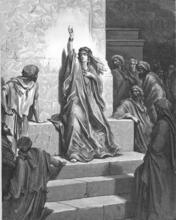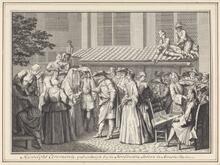Niddah, Tractate
The tractate Niddah is concerned with the halakhic status of a woman’s body. It details and clarifies all of the rules of Niddah, which describes a woman in her menstruation period. The Mishnah contains ten chapters and deals with all topics surrounding menstruation, including genital discharge and the birthing cycle. The Tosefta, containing nine chapters, does not exactly parallel the contents of the respective chapters of Mishnah. There are additions in the Tosefta that are not included in the Mishnah; in addition, many topics in the Mishnah are not addressed in Tosefta. Tractate Niddah is the only tractate from the Order of Tohorot that has Talmud on it.
The Mishnah
Tractate Menstruation; the menstruant woman; ritual status of the menstruant woman.Niddah is the tractate most concerned with women’s physiology and their The legal corpus of Jewish laws and observances as prescribed in the Torah and interpreted by rabbinic authorities, beginning with those of the Mishnah and Talmud.halakhic status concerning body issues. The Codification of basic Jewish Oral Law; edited and arranged by R. Judah ha-Nasi c. 200 C.E.Mishnah contains ten chapters whose main topics are as follows: 1) internal examinations for menstrual blood, retroactive menstrual impurity, and the special categories of girls prior to menarche, pregnant and nursing women, and postmenopausal women; 2) male and female examinations for genital discharges, presumptions regarding purity status, female reproductive anatomy, and types of ritually impure blood; 3) abortion, status of various products of conception in relationship to length of gestation and defective development, birth impurity as opposed to menstrual impurity for abortions, and fetal development; 4) presumptions of menstrual impurity concerning Samaritan, Sadducee, and Gentile women, menstrual impurity as a result of labor, length of labor as basis for imposing impurity for an abnormal discharge, the establishment of minimum cycle length, and the repercussions of neglecting internal examinations; 5) caesarean birth, seminal discharge, and terumah, amount of discharge necessary to transmit impurity, status of genital discharges of newborns and their legal status as human beings, legal age for intercourse, age at which vows become binding, puberty signs, and status of those lacking puberty development; 6) order of puberty sign development, several mishnayot and diverse topics united by formulaic opening, two pubic hairs as sign of legal majority, and the status of bloodstains; 7) purity status of fresh and dry genital discharges, retroactive impurity attached to dead reptiles, purity status of bloodstains, and status of testimony of Samaritans; 8) status of bloodstains in reference to location on body, attribution of bloodstains to various sources, and the status of stains found on checking cloth; 9) purity status of blood after urination, purity status of blood stains found on borrowed clothing, purity status of women sharing a bed, bleaching agents, the establishment of veset (fixed cycle) based on body signs or on time, and hymeneal blood; 10) laws concerning confusion between hymeneal and menstrual blood, purity status when some internal examinations are neglected by the menstruating woman or a woman with an abnormal discharge or woman after birth or the purity status of a man with normal or abnormal genital discharge who neglects to examine himself, niddah status of the dead woman, purity status of blood of purity and sacred foodstuff, and purity status of women at the end of minimum cycle.
Textual evidence for the Mishnah includes Kaufmann (Budapest, Collection Kaufmann A 50), with one page in a different hand from the eleventh or twelfth century, Parma B (De Rossi Parma 497 on Seder Tohorot), Parma (De Rossi 138) from mid-thirteenth century, Lowe (Cambridge: University Library Add. 470:1) from late fourteenth century, Oxford (with Maimonides’s commentary in Arabic), and Paris (with Maimonides’s commentary in Hebrew). The most important textual witness is Antonine, an early Place for storing books or ritual objects which have become unusable.Genizah fragment that covers nearly all the tractate (Meacham). Several other important Genizah fragments exist. The Naples edition of 1492 is the first printed edition of the Mishnah.
There are standard medieval commentaries such as Rabbi Solomon ben Isaac; b. Troyes, France, 1040Rashi and other Rabbinic authorities/halakhic decisors/ biblical commentators of the mid-11th to mid-15th c.. The period of the rishonim followed that of the geonim and preceded that of the aharonim.Rishonim as part of their commentary on the The discussions and elaborations by the amora'im of Babylon on the Mishnah between early 3rd and late 5th c. C.E.; it is the foundation of Jewish Law and has halakhic supremacy over the Jerusalem Talmud.Babylonian Talmud, Moses ben Maimon (Rambam), b. Spain, 1138Maimonides in his commentary on the Mishnah, and later commentators Obadiah of Bertinoro (c. 1450–before 1516) and Tosefot Yom Tov (Yom Tov Lipmann ben Nathan ha-Levi Heller, 1579–1654). The commentary of Hanokh Albeck (1890–1972) on the Mishnah has helpful additional notes, but the most user-friendly commentary is that of Pinhas Kehati (1912–1978), which has recently been translated into English.
Tosefta Niddah
(Aramaic) A work containing a collection of tanna'itic beraitot, organized into a series of tractates each of which parallels a tractate of the Mishnah.Tosefta Niddah contains nine chapters that do not exactly parallel the contents of the respective chapters of Mishnah. For example, there is a large addition on nursing in the second chapter and several expansions and new topics throughout Tosefta; in addition, many topics in the Mishnah are not addressed in Tosefta. In general, Chapter 3 of Mishnah parallels Chapter 4 of Tosefta; Chapter 4 of Mishnah parallels Chapter 5 of Tosefta; Chapter 6 of Tosefta has topics found in Chapters 5, 6 and 7 of the Mishnah; Chapter 7 of Tosefta contains many of the topics found in Chapters 8 and 9 of the Mishnah; Chapter 8 of Tosefta contains the remainder of Chapter 9 of the Mishnah and Chapter 9 of Tosefta parallels Chapter 10 of the Mishnah.
The only complete manuscript of Tosefta is Vienna (National Library Vienna, Hebrew 20). The first printed edition published with Rif (Isaac ben Jacob Alfasi, 1013–1103) in Venice (1521–1522) was based on a different manuscript. That edition—an exceptionally corrupt version of Tosefta—became the basis for the subsequent publication at the back of the Lit. "teaching," "study," or "learning." A compilation of the commentary and discussions of the amora'im on the Mishnah. When not specified, "Talmud" refers to the Babylonian Talmud.Talmud. The Moses Zuckermandel (1836–1917) Tosefta publication in 1880 (republished in Jerusalem 1937, 1970) was not completely accurate. Saul Lieberman’s publication of Tosefet Rishonim compiles quotations from Tosefta by medieval commentators, comparing them to the Vienna manuscript and quotations in the Talmud.
Organization
Tractate Niddah is the only tractate from the Order of Tohorot that has Talmud on it. Talmud Yerushalmi (Jerusalem) Tractate Niddah (48d–51b of the Venice edition 1523–1524) has fully developed discussions for the first two chapters and most of the third chapter. The last sugyah (Talmudic discourse) in Chapter 3 ends abruptly without discussion on the final Mishnah. Chapter 4 contains only a Lit. (Aramaic) "outside." Halakhah and aggadah from the tanna'ic period that was not included in Judah ha-Nasi's Mishnah.baraita similar to Tosefta Niddah 9:10. Although there are discussions elsewhere in Yerushalmi with Talmudic discoursesugyot whose topics are connected to Tractate Niddah Chapters 4–10 and numerous discussions with sages from the The Land of IsraelErez Israel in BT Niddah on those chapters, as well as a few references by medieval scholars, it has not been proven that the final redaction of JT Niddah included the entire tractate (Sussman). Apparently Tosefta Niddah served as the template for the discussions in JT Niddah (Meacham). Textual evidence includes the Leiden manuscript (University Library Leiden, Scaliger 3) completed in 1289, which served as basis for the Venice edition of the Yerushalmi (1523–1524), and a Genizah fragment found in Cambridge on parts of Chapters 1 and 3. The Yerushalmi suffers from lack of commentary in the history of its transmission. As a result, the earliest commentary to JT Niddah is from the eighteenth century (Moses Margolies [d. 1780], Penei Moshe and Mareh ha-Panim). The modern commentaries, especially Yedid Nefesh, often simply re-word Margolies. Alei Tamar occasionally gives a different commentary and sometimes suggests emendations. Ze’ev Wolf Rabinovitz’s Sha’arei Torat Eretz Yisrael and the marginalia in Lieberman’s personal Yerushalmi copy, published by Moshe Assis, present several important commentaries and emendations.
BT Tractate Niddah (2a–76b) is complete. Perhaps the most far-reaching ruling in BT Niddah is on 66a which R. Zeira brings in the name of the daughters of Israel, according to which Jewish women sat seven clean days after the appearance of any uterine blood. This conflates the biblical categories of niddah (normal menstruation) and zavah (the woman with abnormal uterine bleeding. By effectively eliminating the category of normal menstruation, with a ritual impurity time of seven days in total, in favor of the more stringent category of zavah which demands seven clean days after cessation of uterine bleeding, this ruling significantly increased the time in which a Jewish woman was ritually impure and thus unable to have sexual contact with her spouse. The tractate is full of details of interest in the history of obstetrics, gynecology, and sexuality.
The textual witnesses include three Vatican MSS, Munich 95 (Paris 1343), several partial European MSS, and numerous Genizah fragments. Tractate BT Niddah is blessed with many medieval commentaries, most notably that of Rashi. An edition of the extant commentary fragments of Rabbenu Hananel ben Hushiel ben Elhanan (d. 1055) was published in the journal Darom by Elazar Horvitz. There is not yet a modern, academic commentary or critical edition of BT Niddah.







